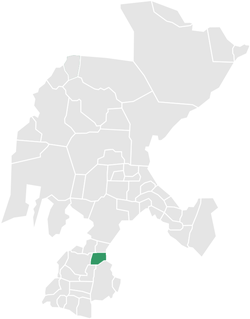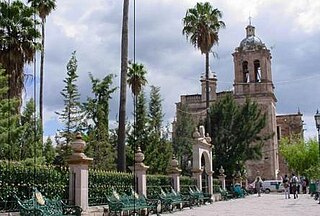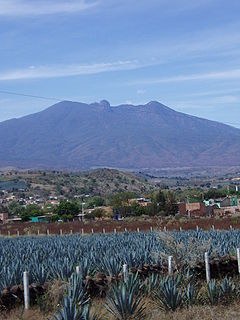External links
Their web site is http://elremolino.com.mx and your blog is http://cerrodelasventanas.blogspot.com
El Remolino is a community that is located in the municipality of Juchipila in the state of Zacatecas in Mexico. The population of "El Remolino" is 737 people and is 1220 meters above sea level.
El Remolino as such was founded in the late eighteenth century, but there are indications that people inhabited the moment that this was founded.
Employer's fair holy cross or Feria Nacional de El Remolino FENARE (National Fair of The Remolino NAFARE) takes place from mid-nineteenth century, in honor of the Holy Cross will be held on 3 May, this holiday began with processions and dances the third day of May, but over the years, things were being added like the peoples theater, amusement rides, among others, which has become one of the most important events in the municipality of Juchipila. These are organized by a committee that is elected by the previous committee, this raises funds for the traditional lottery on Sundays after Mass, with the sale of gorditas on Saturdays and Sundays, and some dinners, etc..
This festival had brought every year without fail until 2009, when he declared influenza pandemic AH1N1 when Zacatecas state authorities prohibit the making of any party bosses. What provoked the discontent of the people, for various reasons such as the arrival of American tourists to this event and especially not performed these tradition, this event was re-organized for late October 2009.
One of the major tourist attractions in El Remolinois the hill of the windows, there was a refuge for groups after the war Caxcanes Mixton, they left many traces, including a cave is a wall with windows, which give its name to the hill.
The main tributaries are El Remolino: The river Juchipila Brook neighborhood above the creek Sanjon, among others.
In El Remolino now part of the population of El Remolino live in the U.S., especially in Los Angeles, California.
With regard to education in the eddy are kindergarten, primary and extramural. The installation of the Polytechnic University of the South of Zacatecas, which benefits the people of El Remolino and so avoid partly emigration to the United States.
With regard to trade, there are several grocery stores, a convenience store, cyber Remolomania, among others.
Their web site is http://elremolino.com.mx and your blog is http://cerrodelasventanas.blogspot.com

Zacatecas is the principal city within the municipality in Mexico of the same name, and the capital and the largest city of the state of Zacatecas. Located in north-central Mexico, the city had its start as a Spanish mining camp in the mid-16th century. Native Americans had already known about the area's rich deposits of silver and other minerals. Due to the wealth that the mines provided, Zacatecas quickly became one of the most important cities in New Spain, with much of its silver enriching the Spanish crown. The area saw battles during the turbulent 19th century, but the next major event was the Battle of Zacatecas during the Mexican Revolution when Francisco Villa captured the town, an event still celebrated every anniversary. Today, the colonial part of the city is a World Heritage Site, due to the Baroque and other structures built during its mining days. Mining still remains an important industry. The name Zacatecas is derived from the Zacateco people and has its roots in Nahuatl. The name means "people of the grasslands".

Fresnillo (/fres'nijo/), founded in 1554 by Francisco de Ibarra, is the second largest city in Zacatecas state, north central Mexico and the seat of Fresnillo municipality. As a rail and highway junction, Fresnillo is the center of a rich mining area known especially for silver, and the location of one of the world's richest silver mines, the Mina Proaño or Fresnillo Mine, which belongs to the Peñoles mining company. It has a mining school, and agriculture and cattle raising are other important economic activities. Fresnillo is also the municipal seat of the municipality of the same name which surrounds it. The municipality had a population of 196,538 and an areal extent of 4,947 square kilometres (1,910 sq mi).

Santiago de Tequila is a Mexican town and municipality located in the state of Jalisco about 60 km from the city of Guadalajara. Tequila is best known as being the birthplace of the drink that bears its name, “tequila,” which is made from the blue agave plant, native to this area. The heart of the plant contains sugars and had been used by native peoples here to make a fermented drink. After the Spanish arrived, they took this fermented beverage and distilled it, producing the tequila known today. The popularity of the drink and the history behind it has made the town and the area surrounding it a World Heritage Site. It was also named a "Pueblo Mágico" in 2003 by the Mexican federal government. Tequila has also been famous for being the prime setting in the successful Televisa telenovela Destilando Amor, starring Angélica Rivera and Eduardo Yáñez.

Nochistlán is a city in the Mexican state of Zacatecas. Nuño Beltrán de Guzmán, on December 3, 1531, hired Cristóbal de Oñate to establish a village in Nochistlán; the village would be named Guadalajara to honor Guzmán for having been born in Guadalajara. Guadalajara was founded in Nochistlán on January 5, having as officials Cristóbal de Oñate, Sancho Ortiz de Zúñiga and Miguel Ibarra. They worked at this project for only 16 months and created the first layout of Guadalajara.

Tequisquiapan is a town and municipality located in the southeast of the state of Querétaro in central Mexico. The center of the town has cobblestone streets, traditional rustic houses with wrought iron fixtures, balconies, and wooden windowsills, which is the legacy of its 300-year heritage as a colonial town populated mostly by indigenous people. This, the climate, and the local natural water springs have made the town a popular weekend getaway for cities such as Querétaro and Mexico City, which has led to the construction of weekend homes in the town.

The municipality and town of Totatiche is located in the northern extreme of the state of Jalisco, Mexico between 21°48’30” and 22°06’00” latitude north and 103°20’00” and 103°34’00” longitude east at a height of 1,751 meters (5,745 ft) above sea level. The municipality is bordered on the north and southeast by the state of Zacatecas. On the northeast, it shares its border with the municipality of Colotlán and on the west it is bordered by the municipalities of Villa Guerrero and Chimaltitán.

Ojuelos de Jalisco is a colonial town and municipality in the state of Jalisco, Mexico. The town's 1990 population was 7,265, although by the year 2010 it had increased to 11,881.

Jerez is a town and municipality in the Mexican state of Zacatecas. To distinguish the two, the town is officially called Jerez de García Salinas to honor a 19th-century reformer. The town of Jerez is the local government of 128 other communities, a rural area noted for its production of fruit trees and dairy. The town was named a Pueblo Mágico to attract tourism, as it lies close to the state capital of Zacatecas and offers handcrafts, traditional food and architecture.

The municipality of Tepetongo is located in the southwestern portion of the Mexican state of Zacatecas. It is a town on the border between Zacatecas and Jalisco. It is next to Huejucar and Jerez de García Salinas

The municipality and city of Huanusco is located in the southwestern portion of the Mexican state of Zacatecas.

Encarnación de Díaz is a town and municipality located in the far northeast of the state of Jalisco in north-central Mexico. It is located in a natural pass that connects the Los Altos region of Jalisco to points north, and from pre-Hispanic times until the 20th century, it was a major thoroughfare for north-south travel. The town began as a way station along a road built through this pass in the 17th century, formally becoming a town in 1760. It began to function as a municipality in the latter 19th century, but this status was not confirmed until the early 20th. Transport, along with numerous prosperous haciendas supported the economy of the area until the early 20th century, when travel patterns and the Mexican Revolution spurred its decline. In the 1920s, it was a centre of rebellion during the Cristero War, and the town contains Mexico's only museum exclusively dedicated to this episode in history. It also contains a museum dedicated to various naturally occurring mummies which have been found in the municipal cemetery.

Briviesca is a municipality and a Spanish city located in the north of the Iberian Peninsula, head of the judicial district of Briviesca, capital of the comarca of La Bureba and province of Burgos, autonomous community of Castile and León. According to the demographic data of 2017, the municipality has 6,861 inhabitants, being the 4th most populated in the province. The municipality of Briviesca is made up of five towns: Briviesca, Cameno, Quintanillabón, Revillagodos and Valdazo.

Viver is a town in the Castellón province of Valencian Community, Spain. It is in the comarca (region) of Alto Palancia.

Zacatecas, officially the Free and Sovereign State of Zacatecas, is one of the 32 states of Mexico. It is divided into 58 municipalities and its capital city is Zacatecas City.

Villanueva is a city in the state of Zacatecas, Mexico. It is the administrative seat of the municipality of Villanueva.

Cuquío is a town and municipality, in Jalisco in central-western Mexico. The municipality covers an area of 252 square miles (653 km²). It limits to the North with the municipality of Yahualica and the State of Zacatecas; to the South, Zapotlanejo and Acatic; to the East, Yahualica and Tepatitlán; and to the West, Ixtlahuacán del Río. Its name derives from the word Cuixui, which in the Aztec language Náhuatl means kite, and is interpreted as "place of kites," or in Tarascan language, "place of frogs or toads." The foundation of the town is awarded to the Purépechas (Tarascans) who repeatedly ventured through these valleys after the Saltpeter War (1480-1510). As a third version about the origins of the municipality name, it is well known that the tribe of coquias settled in La Cofradía, two kilometers from the current town, whose name is conjectured the denomination comes from. Cuquío also depended on the Tonalteca kingdom.

El Arenal is a town and municipality in the state of Jalisco in central-western Mexico. El Arenal is known as the gateway to the so-called "blue agave" region in the Jaliscan Highlands. The municipality has an area of approximately 182 square kilometres (70 sq mi).
El Teúl is an important archaeological mesoamerican site located on a hill with the same name in the Teúl Municipality in the south of the Zacatecas State, Mexico, near the Jalisco State.
Moyahua de Estrada Zacatecas is one of the southern municipalities in Zacatecas State in theme border with the state of Jalisco.
Monte Escobedo Municipality is a municipality located in the southwestern area of the Mexican state of Zacatecas. With a total population of 8,929 people, that municipality was given in 1820, when the Cortes of Cádiz in Spain was established.